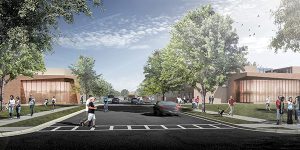In the 21st Century
Education Village Enters Phase II
Winona State University College of Education Dean Tarrell Portman knows almost every square foot of the Wabasha Hall-Wabasha Rec-Cathedral School complex a few blocks east of the main campus. She has walked through the buildings countless times, gaining an appreciation of their history while playing a key role in developing their future as the Education Village.
“The most exciting thing about the project is being able to think outside the box when it comes to preparing educators,” Portman said. “It’s rare for a College of Education to be able to re-invent itself. This project allows us to maintain our tradition while looking into the future.”
The Education Village will continue a legacy of innovative teacher preparation that began more than 150 years ago. Winona State Teachers College was founded in 1858 as the first “normal” school west of the Mississippi, with a mission to train teachers during the country’s expansion into the frontier. Following the sesquicentennial in 2008, WSU began to explore ideas for 21st century teacher preparation, which led to the idea of Education Village.
WSU’s plan is to convert 82,000 square feet of the Wabasha-Cathedral buildings into state-of-the-art teaching and learning spaces. Labs, classrooms, and open area will be designed to be integrated and flexible, allowing WSU students to be fully prepared for their teaching environments.
The Wabasha and Cathedral buildings have deep roots as educational centers in Winona, dating back to the 1920s, serving as the site of a parochial grade school and Cotter High School.
“It is good stewardship to take these buildings and breathe life into them and what is really a wonderful educational history. We are honoring that history of education in Winona and Southeast Minnesota,” Portman said.
Education majors make up 20 percent of the WSU student population, reflecting the university’s strong reputation and commitment to training outstanding teachers. Education Village will push WSU ahead even further.
WSU received $5.9 million in 2014 for the initial planning and construction phases. Phase II funding of $25.3 million was recommended in Governor Mark Dayton’s proposed bonding bill released in January 2016, recognition of the project’s importance to WSU and the State of Minnesota. On the timeline currently in place, renovations would begin in the summer of 2016 and the Education Village would be fully operational for the 2018-19 academic year.
While the physical work is being done, the WSU College of Education will continue programs already in place, such as Teach21, which includes clinical placement in the student’s first year of study, while developing new, innovative programs designed to maximize the Education Village’s potential.
Nicole Nicpon ’16, an elementary education-early childhood development major, has served as a student spokesperson for Education Village and had the opportunity to address Minnesota legislators during the bonding tour stop at WSU in October 2015.
“I’m so excited to see the opportunities that will arise for WSU students from this project,” Nicpon said. “I look forward to what it will do for our program and our school. Winona State is already known for great teacher education, this is going to put us light-years ahead.”
Portman, along with President Scott Olson, alumni, and current and former COE faculty, envision programming that will cover a broad range of content, including STEM (Science, Technology, Engineering, and Math), communications, health, music, art, history, social studies, language, physical education, assisted/adaptive learning, and more, while using the new learning spaces and cutting-edge technology. Education Village will also serve as a center for pre-Kindergarten to 12th grade visiting students, workshops, professional development, educational events, and community programs.
“It is the trail that was blazed in 1858,” Portman said. “We’re moving forward on that trail.”

